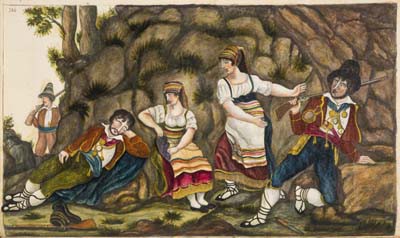This manuscript of 4 volumes of nearly a thousand pages written by the soldier Chevalier is a lifetime’s work. The author debuted editing it in 1830 and during nearly twenty years he ordered notes he had accumulated in the course of his career and illustrated himself. He tells us in his introduction that he is writing his memoirs with the aim of publishing them. The account is told through three themes which merge in the text; firstly the “memoirs” which relate to the life of the author outside of his military campaigns; next the “journeys” in which we read Chevalier’s observations about the countries he visited, their inhabitants and their customs; finally the “Campaigns in Europe” which relate his military career with much detail and anecdote. This last part is the only one ever to have been published.
In 1795, aged fifteen, Jean Michel Chevalier entered the armoury Manufacture Nationale d’Armes at Versailles as a labourer. In September 1800, he began a career in the 7th half-brigade naval artillery and then by chance in 1801 he joined the 9th regiment of the chasseurs à cheval. He underwent six months of training at the depot of the regiment at Vienne and then departed for Italy, where he served six long years. He rapidly rose in rank and thus possessing very precise knowledge, he began to take notes and make sketches.
In 1806, Chevalier and his regiment took part in the campaign in Naples and fought the Calabrese insurrection, in which he was injured and honoured for his bravery. He gives a remarkable account of the everyday life of the French troops during that period and particularly the cruelty of war. Having lost his sketches in Calabria, the pictures of the insurgents in the volume were most likely made at a later date. Nothing distinguishes the men from the women, the brigands who fascinated artists and writers throughout the whole of the nineteenth century, from Gericault to Hebert and Stendhal to Hugo.
On 3 November 1808, Chevalier was promoted to the regiment of chasseurs à cheval of the imperial guard. He served in Austria and took part in the battles of Essling and Wagram, which he describes in detail. In 1810 and 1811, his regiment escorted the Emperor on his diplomatic journeys across Europe; Chevalier describes the different countries he saw. In 1812, he was active in Russia; from the march to Moscow to the retreat, he provides a fascinating account, even if we cannot be certain he was present at all the events he describes. He then fought in Prussia in 1813 and had the honour of carrying the regimental eagle at the battles of Leipzig and Hanau. During the campaign in France, he was at La Rothière, Montmirail and Arcis sur Aube. In 1815, he followed the Emperor to Waterloo, then he retired under the Bourbon restoration. He took up residence at Choisy-le-Roi and married Henriette Pasquier in 1818, with whom he had three sons. In 1842, he moved to paris, where he often visited the old soldiers he served with and took part in reunions of the Société des débris de l’armée impériale. He was widowed in 1853, and consequently given a place to live at les Invalides. He died in 1865 aged 85.
Thierry Viette V (tr AM, July 2013)
This object was on display as part of the exhibition at the Musée de l’Armée in Paris, Napoléon et l’Europe, from 27 March 2013 to 14 July 2013.


